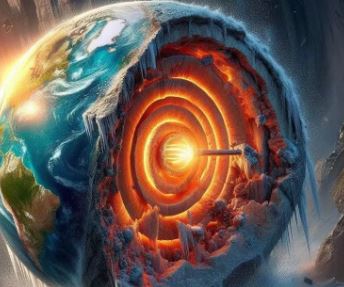Understanding Earth’s Inner Dynamics
In an astonishing revelation, recent scientific studies have indicated a significant shift in the rotational behavior of Earth’s core. The inner core, composed predominantly of iron and nickel, is now believed to be rotating in the opposite direction to the rest of the planet, with its rotational speed progressively decelerating. This groundbreaking discovery offers a new perspective on the dynamic processes occurring deep within our planet.
The Complexity of Earth’s Composition
The Earth’s internal structure is more intricate than previously thought, consisting of three primary layers: the crust, mantle, and core. The core itself is divided into a solid inner core and a liquid outer core. This liquid outer layer acts as a barrier, allowing the inner core to spin independently of the mantle and crust. This independence has led to a myriad of hypotheses and studies regarding the core’s rotational dynamics.
Earth’s Core: The Heart of the Planet
Situated approximately 5,180 kilometers beneath the Earth’s surface, the core is the hottest part of our planet, with temperatures comparable to the Sun’s surface. The solid inner core, surrounded by the fluid outer core, behaves like a hot, dense ball of metal, spinning at its own pace. This unique characteristic has intrigued scientists for decades, leading to extensive research to decipher its behavior.
Historical Context and Recent Discoveries
The concept of an independently rotating core was first proposed in 1936 by Danish seismologist Inge Lehmann, who discovered the planet’s inner core. Since then, scientists have sought to understand the core’s rotation, despite the challenges posed by the inability to observe or sample it directly. Most insights have been derived from analyzing seismic waves generated by earthquakes and man-made explosions.
The New Findings
Recent research published in the journal Nature in June 2024 has brought new clarity to the subject. By examining seismograms from repeated seismic events, scientists have observed a consistent decrease in the core’s rotational speed relative to the Earth’s surface. This deceleration has reached a point where the core’s rotation is now in reverse.
Implications of the Core’s Changing Rotation
The revelation that Earth’s core is slowing down and reversing direction has profound implications for our understanding of the planet’s geophysical processes. This phenomenon is part of a long-term pattern of oscillations in the core’s rotational speed, as proposed by a model introduced in 2023. According to this model, the core has historically alternated between periods of faster and slower rotation compared to the crust.
The Core’s Oscillatory Behavior
The 2023 model suggested that the core initially spun faster than the Earth’s crust. Over time, the rotational speeds of the core and crust aligned before the core’s speed decreased further, eventually reversing. This cyclical behavior is thought to occur over decades, reflecting complex interactions between the core and the rest of the planet.
Scientific Insights and Future Research
The continuous study of Earth’s core provides invaluable insights into the planet’s evolution and its current geodynamic state. Understanding the core’s rotation is crucial for several reasons, including its influence on the Earth’s magnetic field, seismic activity, and overall stability.
The Role of Seismology
Seismology plays a pivotal role in unveiling the mysteries of the Earth’s core. By analyzing seismic waves and their travel times, scientists can infer changes in the core’s behavior. This indirect method, while challenging, has proven to be the most effective means of studying the core’s dynamics.
Broader Implications for Earth Sciences
The discovery of the core’s reversed rotation adds a new dimension to the study of Earth’s internal processes. It prompts a reevaluation of existing models and theories, encouraging scientists to explore new hypotheses about the interactions between the core, mantle, and crust.
Earth’s Magnetic Field
One of the significant implications of the core’s rotational changes is its impact on Earth’s magnetic field. The geodynamo effect, responsible for generating the magnetic field, is influenced by the movements of the liquid outer core and the solid inner core. Changes in the core’s rotation could potentially affect the strength and orientation of the magnetic field, with far-reaching consequences for the planet.
Conclusion: A New Frontier in Geophysical Research
The revelation that Earth’s core is now rotating in reverse and slowing down marks a new frontier in geophysical research. It underscores the dynamic nature of our planet and the continuous evolution of its internal processes. As scientists delve deeper into the mysteries of the core, each discovery brings us closer to understanding the intricate workings of Earth.
Summary of Key Learning Points
| Key Points | Description |
|---|---|
| Complexity of Earth’s Composition | Earth’s core consists of a solid inner core and a liquid outer core, with independent rotational behavior. |
| Historical Context | Danish seismologist Inge Lehmann discovered the inner core in 1936, sparking ongoing research. |
| Recent Discoveries | New studies indicate the core is now rotating in reverse and slowing down. |
| Oscillatory Behavior | The core’s rotation speed has alternated over decades, reflecting complex interactions with the planet. |
| Seismology’s Role | Seismic wave analysis is crucial for studying the core’s dynamics and understanding its behavior. |
| Implications for Earth’s Magnetic Field | Changes in core rotation affect the geodynamo effect, influencing the Earth’s magnetic field. |
| Broader Implications | The findings prompt reevaluation of existing models and encourage exploration of new hypotheses. |

Basant Kumar Sahoo is a seasoned writer with extensive experience in crafting tech-related articles, insightful editorials, and engaging sports content. With a deep understanding of technology trends, a knack for thought-provoking commentary, and a passion for sports, Basant brings a unique blend of expertise and creativity to his writing. His work is known for its clarity, depth, and ability to connect with readers across diverse topics.



